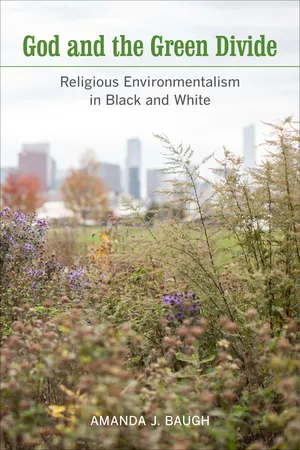God and the Green Divide
About this book
American environmentalism historically has been associated with the interests of white elites. Yet religious leaders in the twenty-first century have helped instill concern about the earth among groups diverse in religion, race, ethnicity, and class. How did that happen and what are the implications? Building on scholarship that provides theological and ethical resources to support the "greening" of religion, God and the Green Divide examines religious environmentalism as it actually happens in the daily lives of urban Americans. Baugh demonstrates how complex dynamics related to race, ethnicity, and class factor into decisions to "go green." By carefully examining negotiations of racial and ethnic identities as central to the history of religious environmentalism, this work complicates assumptions that religious environmentalism is a direct expression of theology, ethics, or religious beliefs.
Frequently asked questions
- Essential is ideal for learners and professionals who enjoy exploring a wide range of subjects. Access the Essential Library with 800,000+ trusted titles and best-sellers across business, personal growth, and the humanities. Includes unlimited reading time and Standard Read Aloud voice.
- Complete: Perfect for advanced learners and researchers needing full, unrestricted access. Unlock 1.4M+ books across hundreds of subjects, including academic and specialized titles. The Complete Plan also includes advanced features like Premium Read Aloud and Research Assistant.
Please note we cannot support devices running on iOS 13 and Android 7 or earlier. Learn more about using the app.
Information
Table of contents
- Cover
- Contents
- Acknowledgments
- Introduction
- 1. People, Not Polar Bears: Faith in Place’s First Ten Years
- 2. Religious Environmentalism in the City
- 3. Paths Leading to Faith in Place
- 4. Food and Environment at an African American Church
- 5. Finding Racial Diversity with Religious Pluralism
- 6. Faith in Place’s Religious Message
- 7. From Grassroots to Mainstream
- Conclusion
- Notes
- Bibliography
- Index
